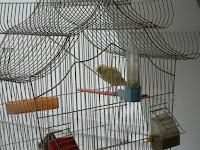After lunch, we headed for Kairouan and the Hotel Splendide. The room had a lot of mirrors and was nice and light, but the shower did not look too clean. We had half an hour to unpack and get ready for a tour of the medina. Just before we left the room, the nearby mosque started the call to prayer. We wouldn’t need our alarm clocks the next morning!
On heading into the medina, my intention was to look for skirts whilst the others had the promised trip into a carpet shop, but this did not happen. Instead, Lotfi quickly led us from one side of the medina to the other along the Rue 7 Novembre, which is a very wide road for a medina. We passed several leather shops and other shops selling very colourful spices. There was some jewellery and quite a few clothes shops, but there was no time to look and, at first glance, they did not sell what I was looking for.
 |
| Bir Barouta |
It started to rain and the stalls were put away, so we went into the Bir Barouta. This is a sacred well. The water is raised by a muzzled and blindfolded camel working a sakia. Lotfi assured us that the camels worked two hour shifts and were then changed. We stood round the edge of the room and watched him and I was able to stroke him when the “performance” was over. The hair on the front of his neck was surprisingly soft.
It was still raining when we emerged, so we took shelter in an enclosed part of the medina. But the rain showed no signs of stopping, so we set off in search of a “typical” old house which Lotfi wanted to show us. The trouble was that he was unsure of the way. At one point we went into a carpet shop to ask for directions. The people inside started to get excited at the prospect of customers, but it was short lived as we left before they were able to get any carpets out. One of the streets we walked down was completely flooded. My feet, in my open sandals, felt horribly gritty. Some of us were prepared and wore raincoats, but I just had my normal clothes for the day. I contented myself with the thought that my hair would be lovely and soft after all the rain.
Eventually we did find the house and walked in looking like drowned rats. Despite that, we were welcomed in and we were even allowed to sit on the seats, dripping copious amounts of rainwater. The house had been used by the main family in Kairouan until just 10 years ago. The grandson of the family was actually in the house during our visit.
The house had two reception rooms near the entrance: one for men and one for women. The women’s room had tilted mirrors above the divans so they could admire themselves. The kitchen was behind the women’s room. There was just a small stove but a huge range of copper cooking pots of various shapes and sizes. The bedrooms had a sleeping alcove at each end. This was true even of the marital bedroom so that the wife could sleep alone when pregnant or when she had a new baby. There were some steep stairs which led to a store room, but you had to go down backwards so I did not try.
The central courtyard was full of plants. It was overlooked by an upstairs balcony decorated in wrought ironwork. We went up and saw some more reception rooms with wonderful antique chairs. The guest bedroom was here, also with two beds.
We went up some more stairs to the roof. Unfortunately this was open to the rain, so we did not stay long. On a sunny day, it would have been pleasant to sit up here and enjoy the views while drinking tea. Instead we went back down to the men’s reception room for the most welcome tea and pastries. I tried some of the makhroud, which are local delicacies made from dates. They were surprisingly nice. While we ate, the grandson took our photos. I don't think that we made a good advert for the place in such a soggy state. As we were leaving, I looked at the photos of the family when they lived in the house. The grandson seemed so happy to have us as visitors, it was quite touching.
Lotfi had rung Hammadi, who was waiting in the bus by the nearest gate to the medina, so we did not have far to walk. The rain was slowing, so we did not get really wet again. The one way system meant that the bus had to take the long route round town, but we reached the hotel eventually. Sparrows were coming in to roost in a nearby tree and there was lots of chirping despite the rain.
Caroline and I chilled out in the room, drinking cups of tea made with a travel kettle she had bought in Heathrow. It did not seem to be working very well. The call to prayer started again. It was a real auditory experience, enhanced by the birdsong emanating from the roost.
At 19.20 we went for our daily briefing and then braved the rain to walk to a nearby restaurant. Luckily it was not too far. We all sat upstairs and opened the window. We heard a wedding procession go past. Not a good day for a wedding! It was still raining when we finished dinner. I went straight back to the hotel and bed, but Caroline and some of the others stayed out.





















































